The Drawing Room
This room, along with the Saloon, retains its original late eighteenth-century plasterwork ceiling. The white marble chimney-piece, with its central plaque of a reclining Muse, is also original to the room, which was redecorated in 1988 by Imogen Taylor of Colefax and Fowler.
Pictures
Some of the Italian paintings here were bought by the 1st Lord Faringdon, but the majority were acquired by the 2nd Lord Faringdon. The most recently acquired is the one that dominates the room: the beautifully preserved painting by Giovanni Battista Pace of St Jerome (no.42), which was in the Barberini Collection in Rome until 1964. The asymmetrical composition of the Mystic Marriage of St Catherine, by Palma Vecchio (no.46), over the fireplace, is explained by the fact that the figure of the Baptist has been cut away from the left. Tondi (circular paintings) hang on either side: on the right is The Holy Family with St John the Baptist by Sandro Botticelli (no. 47), and on the left is Madonna and Child with the Infant St John by a follower of Leonardo (no. 45).
Furniture
Most of the furniture acquired for this room by the 2nd Lord Faringdon dates from the period immediately after Loveden’s building of the house – the 1780s and 1790s – and is thus particularly appropriate in these surroundings. The collection of satinwood and rosewood furniture by Seddon, Sons & Shackleton is remarkable for the unusual painted peacock-feather decoration adorning each piece. The collection includes the six shield-back chairs, a pair of semi-circular card-tables, two Pembroke tables and the pair of side tables on either side of the fireplace. A similar set of chairs, painted with peacock feathers and flowers, is in the Victoria & Albert Museum.
The set of six oval-back chairs and settee in giltwood are in the Adam style of about 1775. The writing-table, on which stands a French Empire ormolu mantel-clock attributed to the bronzier Jean-André Reiche, is a good example of a Carlton House desk. So named, according to Rudolf Ackerman in his Repository of Arts of 1809–28, ‘from having been first made for the August personage whose correct taste has so classically embellished that beautiful place’: the Prince Regent, later George IV. The prototype Carlton House desk was probably made by Robert Campbell around 1780–90. Both Hepplewhite and Sheraton published patterns in 1795 and 1802, respectively, and several leading cabinet-makers produced their own versions, including Gillows, who may have made this particular desk.
On the chimney-piece is a small clock in ormolu and lapis lazuli by James Cox (fl.1760–88), designed as a two-handled vase. The chandelier is English, originally from Devonshire House in Piccadilly, and is one of a rare series introduced by Perry & Co. in the 1830s, which dispensed entirely with drops and relied instead for its brilliance and luminosity on the sculptural properties of the glass.
The freestanding bracket cabinet of two tiers is in the style of the eighteenth-century designer, Robert Adam, and was commissioned from Thomas Messel in 2012 to house a collection of Maiolica plates purchased at auction in 1950 from the collection of Henry Harris, mainly made in Urbino in the mid-sixteenth century. The dish painted with Scipio volunteering to command a Roman army (c.1545) is the work of Francesco Durantino, one of the most prolific of the Urbino maiolica painters. Also by Durantino is the bowl depicting the Death of Aeneas and the dish showing the stories of Echo and Narcissus, from Ovid’s Metamorphoses. Other classical subjects include the Sword of Damocles, the Bath of Venus and Apollo in his chariot, while another is decorated with Adam and Eve and the Sacrifice of Cain.
The lower vitrine contains honours awarded to the 1st, 2nd and 3rd Lords Faringdon.
Ceramics, Sculpture and Objets d'Art
On the side-tables are two seventeenth-century Italian earthenware chargers, painted in blue and white, an Austrian rock-crystal bowl supported by a satyr modelled in ormolu, a Viennese early eighteenth-century rock-crystal and enamelled casket, and an early nineteenth-century Wedgwood vase in the form of an Egyptian canopic jar and cover. On the table behind the sofa, the four modern bronzes are the work of Francesco Cenci of Florence.
Further objets d’art include a collection of Derbyshire fluorspar or ‘Blue John’ (some of it on the chimney-piece); three Kangxi (1662–1722) cloisonné enamel koros (incense burners) with bronze mounts; a seventeenth-century statue of the Virgin and Child in semi-precious stones, probably from the Florentine Grand-Ducal workshops; and a Spanish or Flemish carved ivory figure of the Virgin of the same date or slightly later.
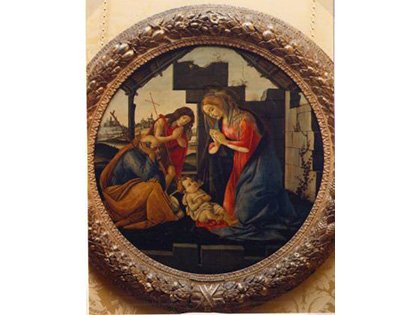
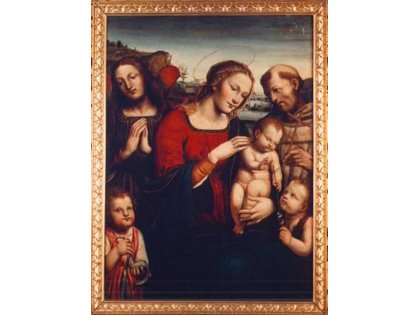
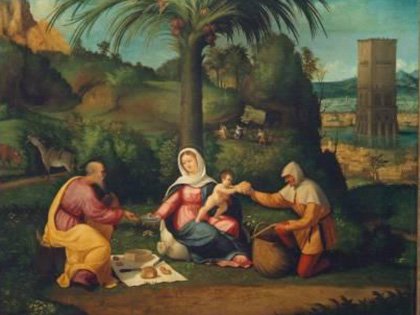
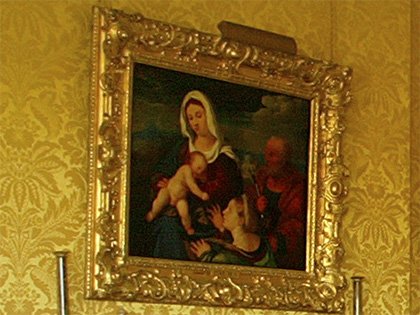
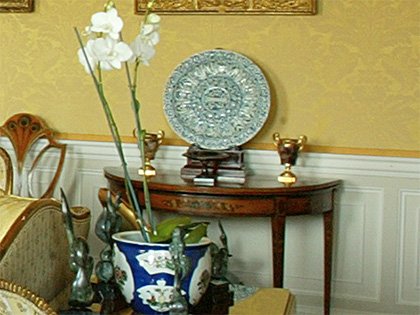







 = House & Grounds Open
= House & Grounds Open = Grounds Open Only
= Grounds Open Only = Closed
= Closed

 >
>